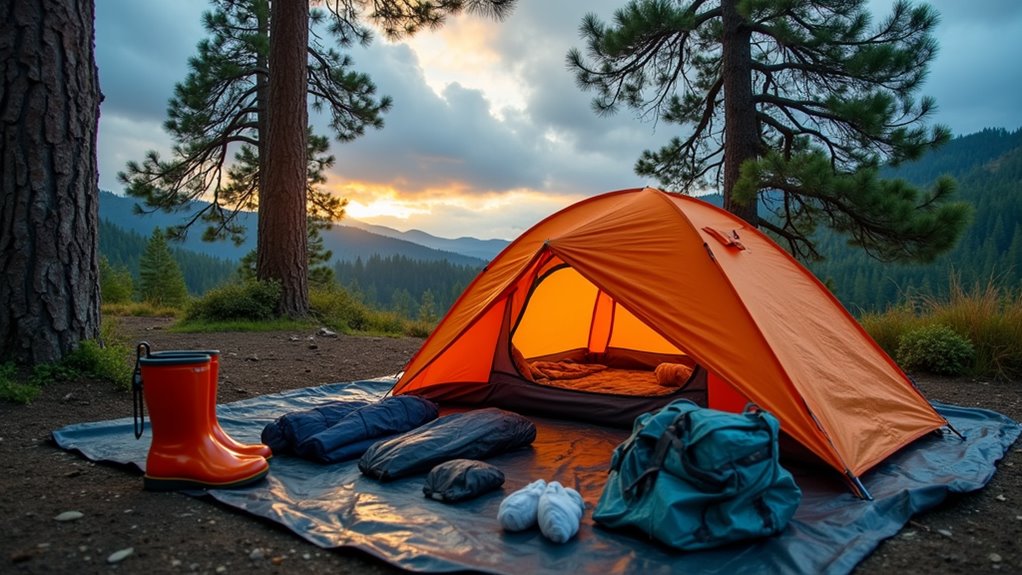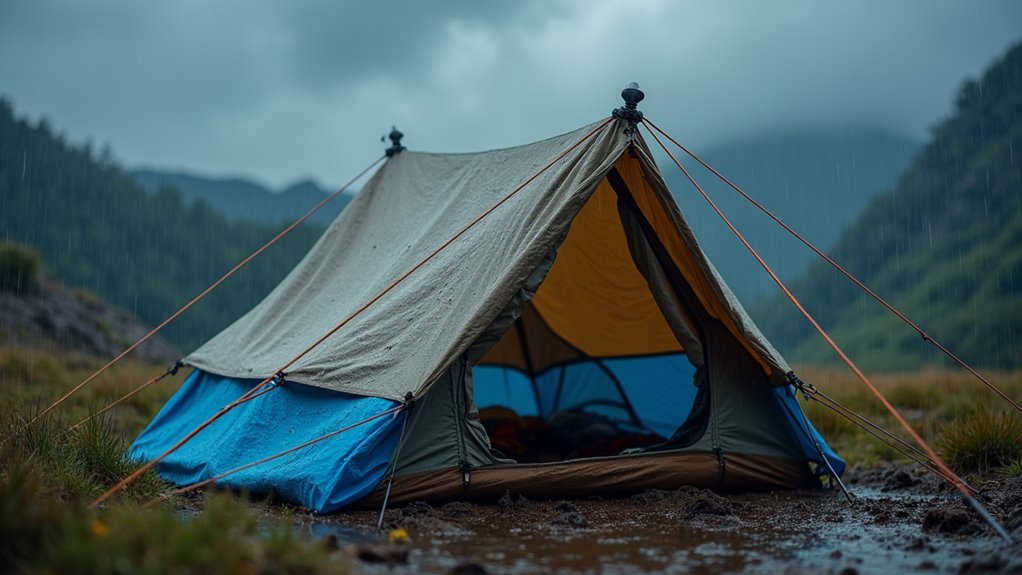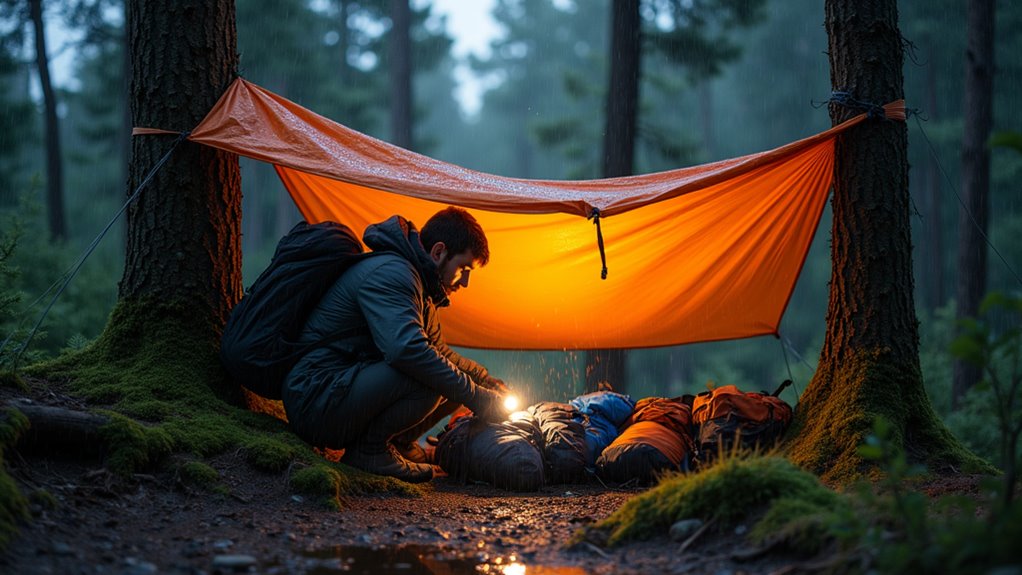Physical Address
304 North Cardinal St.
Dorchester Center, MA 02124
Physical Address
304 North Cardinal St.
Dorchester Center, MA 02124

Wondering how to turn rain camping from a soggy disaster into an unforgettable adventure through smart planning and preparation?
You’ve probably heard horror stories about soggy sleeping bags, collapsed tents, and miserable campers huddled in their cars waiting for storms to pass. But here’s the thing—rain camping doesn’t have to be a nightmare if you know what you’re doing. The difference between a disaster and an adventure often comes down to preparation and smart decision-making before you even leave home. Let’s explore how proper planning transforms wet weather from your worst enemy into just another part of the experience.

When rain threatens your camping trip, your gear selection becomes the difference between a miserable ordeal and an enjoyable outdoor adventure. You’ll need a waterproof tent with a full rainfly and sealed seams, plus a footprint to prevent ground moisture from seeping through.
Pack a reliable rain jacket and pants made from breathable, waterproof materials like Gore-Tex. Don’t forget waterproof boots with good traction for slippery terrain.
Your rain gear is your armor against the elements – waterproof, breathable layers and grippy boots transform stormy conditions into manageable adventures.
Inside your tent, use a sleeping pad that insulates you from cold, damp ground. Bring extra tarps for creating dry cooking and gathering spaces. Pack everything in waterproof stuff sacks or dry bags.
Quick-dry clothing materials like merino wool and synthetic fabrics will keep you comfortable when cotton would leave you cold and clammy. Consider packing camping showers to maintain personal hygiene even when natural water sources are limited or contaminated by runoff.
Having the right gear sets you up for success, but your campsite selection can make or break your rainy weather experience. You’ll want to avoid low-lying areas where water naturally collects – valleys, depressions, and spots near streams that could flood. Instead, look for slightly elevated ground with good drainage.
Check the terrain around your tent site. Slopes should drain away from where you’ll sleep, not toward it. Hard-packed soil sheds water better than loose dirt that turns muddy.
Scout for natural windbreaks like trees or rock formations, but don’t camp directly under large branches that could fall. Look for existing clearings rather than areas thick with vegetation that’ll drip continuously.
Finally, consider proximity to your vehicle – you’ll appreciate shorter trips when hauling wet gear. Research potential camping grounds thoroughly before your trip to identify sites with the drainage features and terrain characteristics that work best for wet weather conditions.

Once you’ve found your ideal spot, proper tent setup becomes your first line of defense against the elements. Start by laying down a footprint or tarp that’s slightly smaller than your tent’s floor to prevent water pooling underneath.
Stake out your tent tightly, ensuring the rainfly doesn’t touch the inner walls – this prevents condensation transfer. Angle guy lines at 45 degrees for maximum stability against wind gusts.
Create drainage channels around your tent using rocks or sticks to divert runoff. Double-check all zippers work smoothly before the rain starts.
Pack extra stakes since wet ground can cause them to pull loose. Finally, test your setup by gently shaking the tent – it shouldn’t wobble excessively.
Consider whether renting camping gear makes more sense than purchasing if you’re new to rain camping or only camp occasionally.
Even though heavy rain might derail your hiking plans, you’ll discover that tent time can become the highlight of your camping trip with the right activities. Pack a deck of waterproof cards for poker or Go Fish sessions that’ll keep everyone entertained for hours. Bring travel-sized board games like chess, checkers, or Yahtzee that won’t take up much space in your pack.
Storytelling becomes magical when rain’s drumming on your tent walls. Take turns sharing ghost stories or childhood memories. Pack a journal to document your adventure or sketch the rain patterns you observe.
Don’t forget portable chargers for devices loaded with audiobooks, podcasts, or downloaded movies. Consider bringing craft supplies like friendship bracelet materials or small puzzles to keep hands busy during extended downpours.
If you’re new to camping or only go occasionally, consider renting camping gear instead of purchasing expensive equipment that might sit unused in your garage between trips.

While indoor activities keep you entertained during gentle rain, severe weather demands your full attention on safety protocols. Monitor weather alerts constantly through your phone or weather radio.
If lightning strikes nearby, stay inside your tent and avoid touching metal poles or zippers. Never seek shelter under tall trees during thunderstorms – they’re lightning magnets.
Watch for flash flood signs like rapidly rising water or distant rumbling. Camp on higher ground and know your evacuation routes.
Secure all loose gear that strong winds could turn into projectiles. Keep your tent stakes firmly anchored and guy lines taut.
Pack emergency supplies including extra batteries, a first aid kit, and an emergency whistle. If conditions become dangerous, don’t hesitate to abandon camp and seek solid shelter immediately.
For those who prefer more substantial shelter during unpredictable weather, consider exploring motorhome options that provide better protection from the elements while still allowing you to enjoy the outdoors.
You’ve got all the tools to turn a soggy camping trip into an epic adventure! Don’t let Mother Nature rain on your parade – with proper gear, smart campsite selection, and solid shelter setup, you’ll stay dry and comfy. Pack those board games for tent time, keep your smartphone charged for weather updates, and remember safety first during storms. Now get out there and show that rain who’s boss!